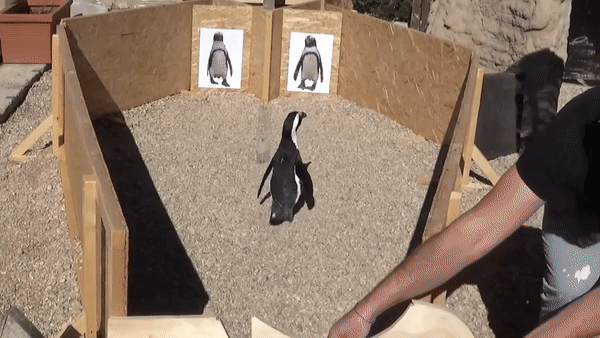African Penguins Tell Each Other Apart by Their Polka Dot Patterns
New research suggests the birds may find their mates in crowded colonies by looking at their chest plumage
:focal(790x526:791x527)/https://tf-cmsv2-smithsonianmag-media.s3.amazonaws.com/filer_public/6e/15/6e158b03-356d-4290-ad69-b61c7226e72f/1-s20-s0003347223002579-gr1_lrg.jpg)
With their nearly identical black-and-white feathers, how can penguins tell each other apart when they’re nesting in huge colonies? At least one species of the iconic, tuxedo-wearing birds may use their mate’s pattern of black polka dots to pick them out of the crowd.
In a series of experiments, African penguins (Spheniscus demersus) appeared to recognize their partners by their unique chest plumage, according to a new paper published in the journal Animal Behavior.
Scientists have long considered the ability to identify other individuals based on visual cues a trait that was “very special and cognitively difficult,” says Mark Hauber, a comparative psychologist at the City University of New York who was not involved in the research, to Science’s Erik Stokstad. The findings seem to indicate, then, that African penguins are more intelligent than previously assumed.
“Given how goofy penguins can seem—almost stumbling over their feet as they walk, for example—the birds may not seem like they are all that bright,” says study lead author Luigi Baciadonna, a psychologist who conducted the research while at the University of Turin, to New Scientist’s Carolyn Wilke. “But we showed… that actually they are quite complicated and complex. They’re also clever.”
African penguins live on the rocky coasts of South Africa, Namibia and nearby islands. They stand a little more than two feet tall and weigh just seven pounds on average. Like other types of penguins, the birds have white feathers covering their chests and black feathers covering their backs. But when they are about three to five months old, African penguins begin to grow a smattering of black feathers on their chests in the shape of polka dots. When the birds molt, their feathers regrow in the same places year after year.
The penguins form lifelong pair bonds with mates, but they nest in huge colonies—so, scientists wondered how the birds were able to identify their partners among the sea of black-and-white birds. They wondered if the chest spots had something to do with it.
To test this theory, they studied 12 African penguins at a zoo and marine park near Rome called Zoomarine Italia. The researchers built a small, wooden, open-top enclosure with walls that were tall enough to prevent the penguins from looking over the top. They gently shepherded one penguin at a time into the pen, where they ran a series of experiments.

In one test, they taped two life-size photographs of other African penguins to the enclosure’s wall. One showed a random member of the colony, while the other showed the test subject’s mate. The scientists recorded the bird’s interactions with the photos, making note of how long they spent looking at each one, as well as how much time they spent standing near each photograph.
The penguins spent more time gazing at the photo of their partner—about 23 seconds longer, on average—than looking at the other photo. They also stood next to the image of their beau for twice as long.
While this suggested the birds recognized their mates, the researchers hadn’t yet demonstrated that the spots were the identifying trait. So, they covered up the heads of the birds in the photographs, leaving only their speckled bodies visible, and the penguins still lingered near their partner’s portrait.
In another experiment, the researchers hung up two photos of the bird’s mate—but, in one, they had digitally removed its spots. In this case, the penguin again spent more time looking at the photo with the dots.
Finally, the researchers posted two photographs of penguins with digitally removed spots—one of the test subject’s mate and the other of a random penguin from the colony. In this scenario, the penguins did not appear to recognize their partners. They spent roughly the same amount of time gazing at or standing near both photos.
Together, the results of these experiments suggest African penguins are zeroing in on their partner’s spots and using them like name tags, scientists say.
“Our results provide the first evidence of a specific visual cue responsible for spontaneous individual recognition by a bird and highlight the importance of considering all sensory modalities in the study of animal communication,” the researchers write in the paper.
This new insight comes as African penguin populations dwindle. The seabirds once numbered two million, but they are now down to just 20,000 individuals in the wild, reports Hakai magazine’s Sarah Wild. Unless something changes, some scientists say the birds are on track to go extinct by 2035.
It’s not totally clear why African penguins are struggling. However, researchers suspect multiple factors may be at play, including unsuccessful breeding efforts, predators eating their eggs and chicks and a scarcity of fish driven by commercial fishing and climate change.
/https://tf-cmsv2-smithsonianmag-media.s3.amazonaws.com/accounts/headshot/SarahKuta.png)
/https://tf-cmsv2-smithsonianmag-media.s3.amazonaws.com/accounts/headshot/SarahKuta.png)